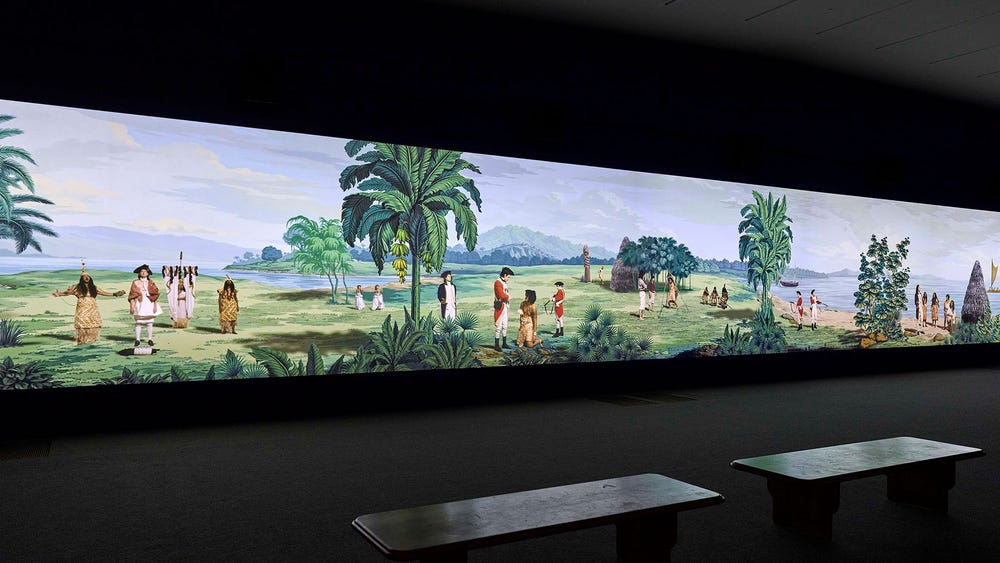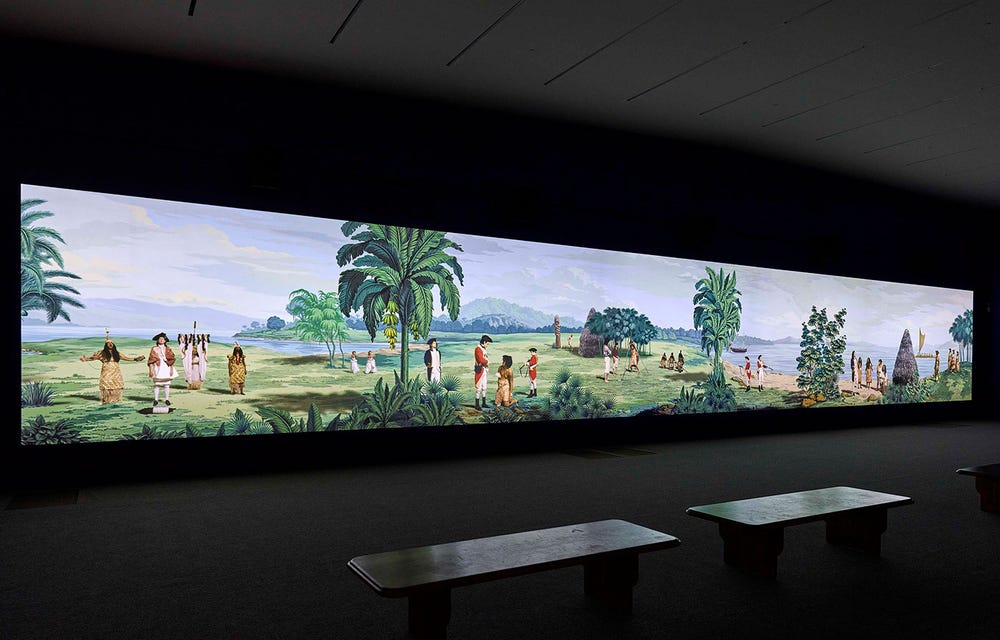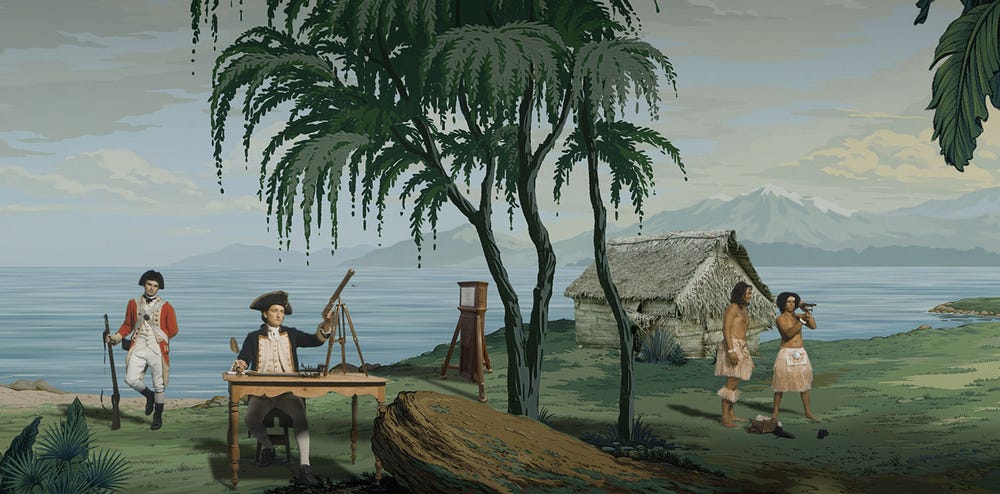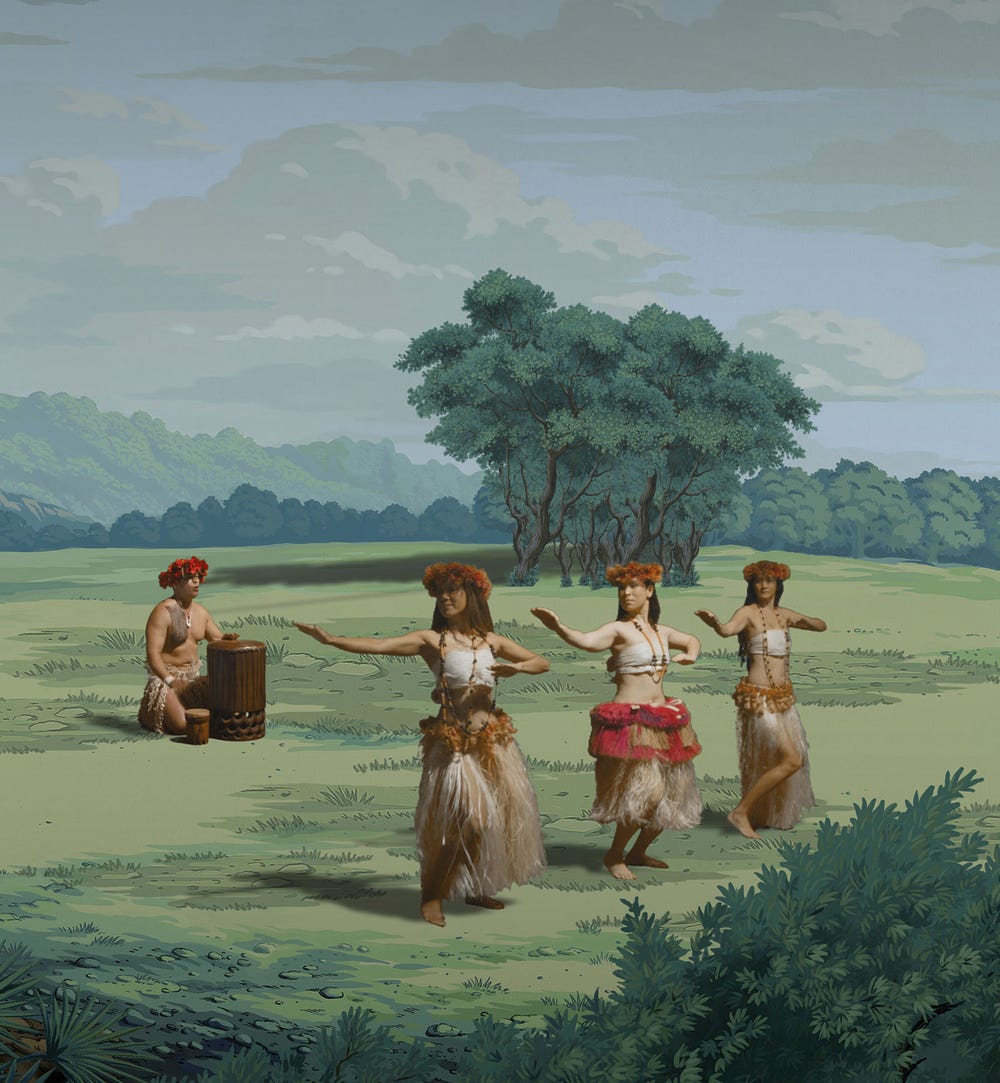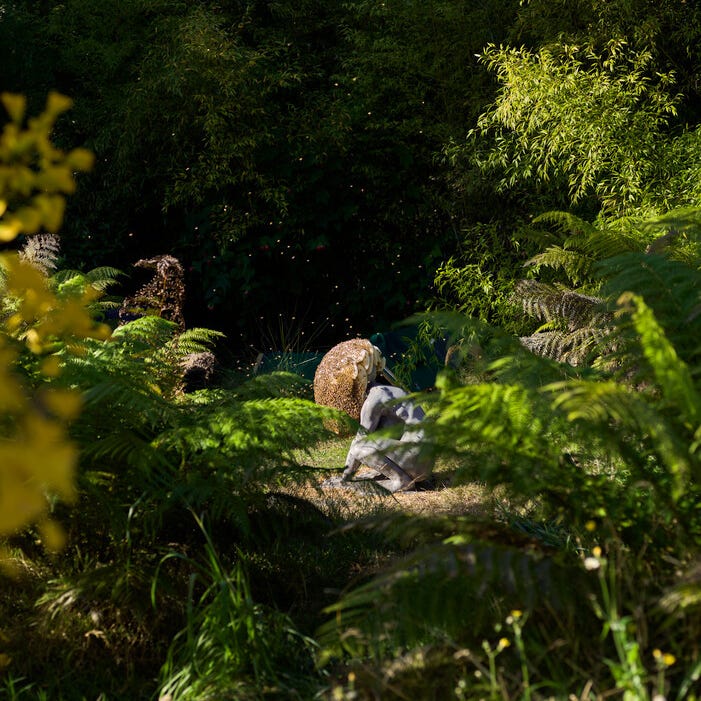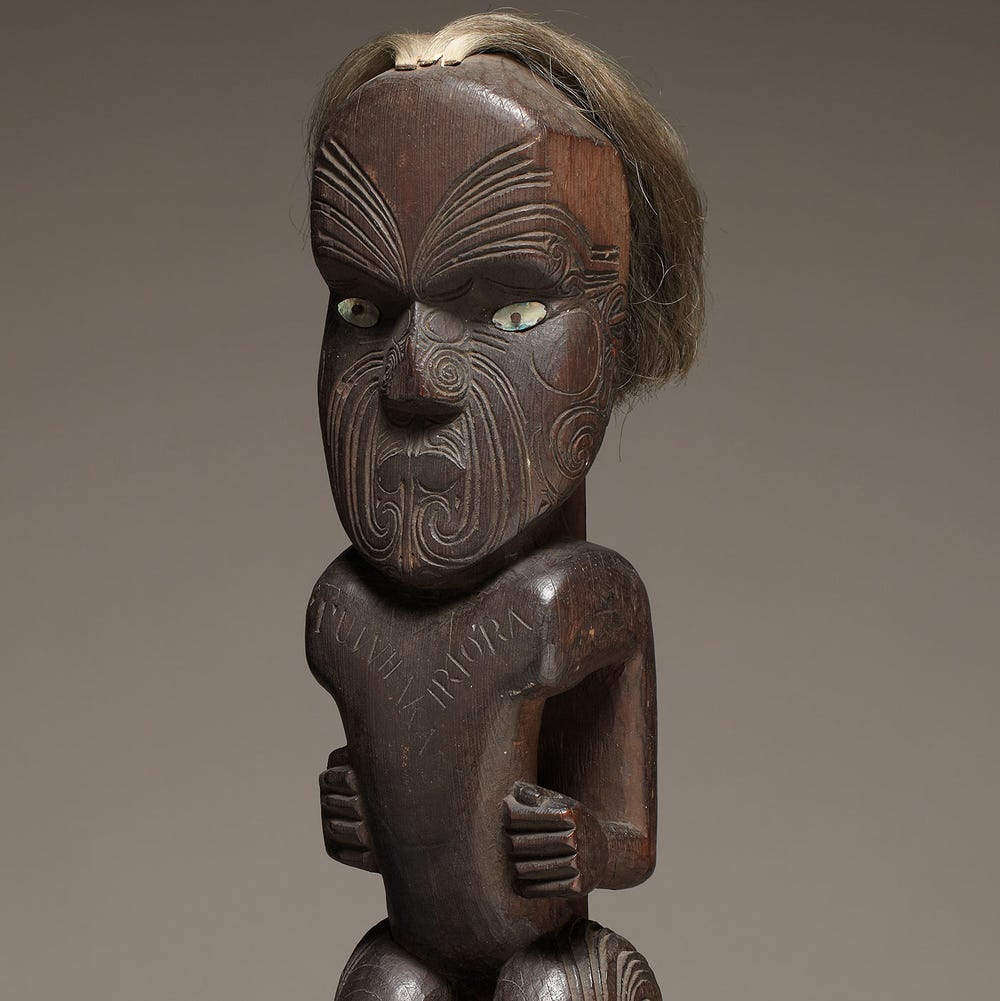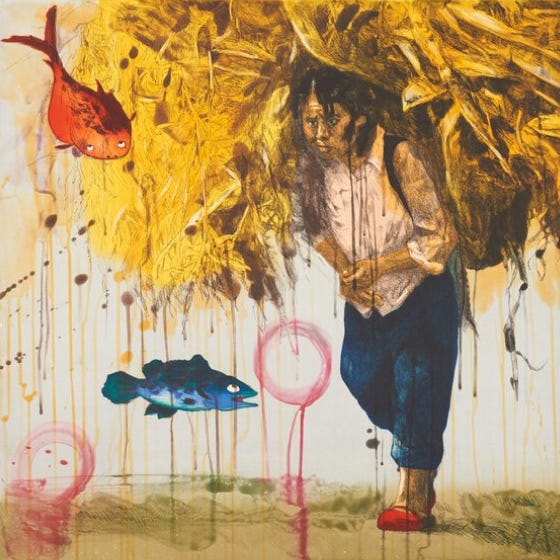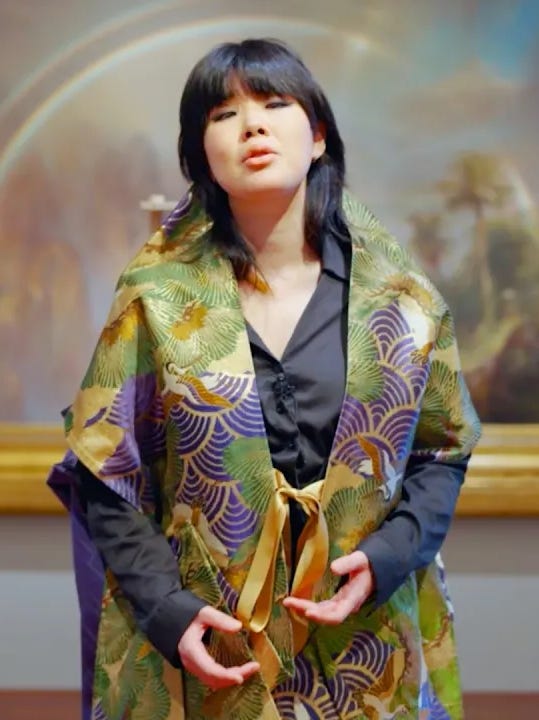In its first exhibition in the continental United States, the artist Lisa Reihana’s extraordinary 70-foot-long video, in Pursuit of Venus [infected] — recently acquired by the Fine Arts Museums of San Francisco — is presented with the French Neoclassical wallpaper (from ca. 1804 – 1806) on which it is based. The experiential video reimagining allows visitors to reflect upon notions about Pacific culture and history that originated with the European voyages of exploration in the 18th-century Age of Enlightenment and persist even today. Below, curator in charge of contemporary art, Claudia Schmuckli, interviews Lisa Reihana.
Installation view of Lisa Reihana: in Pursuit of Venus [infected]
Claudia Schmuckli: You have invested ten years in the research and development of in Pursuit of Venus [infected]. It’s an extraordinary commitment. Did you realize at the outset that this project would command your attention over such a long period of time?
Lisa Reihana: I didn’t know it would take so long to complete. The process was driven by the idea of future proofing, which meant we were developing new production methodologies and working on the cutting edge of technology with its attendant demands. We built three computers (breaking two) in the process of editing; applications came and went, devoured by bigger companies, some unavailable for the final video render. It took a further two years post-Venice to finesse the video to my satisfaction.
CS: How has your relationship to the work changed from the moment of conception to its final manifestation?
LR: It’s been amazing to work so comprehensively on one work over many years. I owed it to the people who appear in the work and who have collaborated on it. I love the process of research, the histories, but also the technology. It has become such a demanding beast that I feel very comfortable discussing tech, seeking new ways to employ it as a tool for communicating feelings and ideas. Funnily enough, the final work is pretty much as I imagined it in my eureka moment — what I didn’t realize was that it would be slowly panning across the screen, a decision initiated by the director of photography and editor Sam Tozer.
Lisa Reihana, in Pursuit of Venus [infected] (detail), 2015–2017. Ultra HD video, color, 7.1 sound, 64 min. Image courtesy of the artist and New Zealand at Venice. With support of Creative New Zealand and NZ at Venice Patrons and Partners
CS: One of the main achievements of the film is the reversal of the imperialist gaze manifest in works like Les Sauvages de la Mer Pacifique. Can you speak to the extent to which the colonial legacy of Captain James Cook’s voyages has shaped the discourse around identity and representation within the Pacific?
LR: There are many different views about Cook, but of course he is held to task by people from all over the Pacific, as so much culture and languages were lost in the wake of these encounters. Many people are boycotting a current series of events dedicated to his commemoration. I admire Cook as a self-made man. Hero or villain, he did his job well, so well that he mapped the coordinates that led to a trail of destruction and stolen resources. You can’t turn back time, and the title of this work reflects this. The inclusion of “[infected]” goes beyond the menace of introduced pathogens to indicate that once you know something, you can’t unknow it.
CS: What prompted you to reimagine the Joseph Dufour wallpaper as a video rather than a still image or a series of still images?
LR: It was important to show living, breathing survivors. in Pursuit of Venus [infected] relates to an earlier work entitled Native Portraits n.19897, based on 19th-century photographs of Māori sitters. Sydney Parkinson’s iconic head of a New Zealander with a moko or tattooed face is the most reproduced image from the entire archive of European travel and defined the conventions and stereotypes I am hoping to break.
— Lisa ReihanaVideo allows me to look beyond that framework and to show these characters as alive, proud, handsome, and strong.
The soundtrack is an emotional driver; it fills the room with languages, song, and ambient sounds that lull the audience into thinking they are outdoors in this utopian, constructed world. Many people have told me that they’ve cried, and so not only does it attract people into the room, it also elicits empathy — something we need more of these days.
Lisa Reihana, in Pursuit of Venus [infected] (detail), 2015–2017. Ultra HD video, color, 7.1 sound, 64 min. Image courtesy of the artist and New Zealand at Venice. With support of Creative New Zealand and NZ at Venice Patrons and Partners
CS: The work plays with concepts of gender, most visibly in your casting of Cook with a woman actor in the final iteration of the work. What informed that decision?
LR: There are a series of vignettes in the work that look at gender politics and different ways of viewing roles. When you read some of the journal accounts by botanist Joseph Banks, Cook, and other explorers of the period, you can read between the lines and see how Pacific people were playing with the visitors to their shores. There’s a funny account about Banks being sent a boy for nightly activities more than once. And as Cook wore breeches covering his genitals, there was uncertainty about his gender. There is a fluidity around gender roles in Pacific societies, so I wanted to signal this in the work as these issues are as important today . . . perhaps more so.
CS: How is time configured in in Pursuit of Venus [infected]?
LR: Even though this work uses Les Sauvages de la Mer Pacifique and historical stories as a starting point, it is a contemporary work of digital art that addresses current concerns. The loop is seamless and endless. I quote anthropologist Nicholas Thomas: “Reenactment necessarily places us, in some sense, ‘after the fact’: it creates a space of theatricality, continuity, discontinuity, and confusion, while always begging the question, ‘Is this present staging of the past, how it was?’ Yet in Pursuit of Venus [infected] overtly infects the past with what are simply performances that Islanders can and do engage in today. In one sense, the work is unambiguous: Oceania is the locus of creativity, the realm of life and art in the present.”
Interview by Claudia Schmuckli, Curator in Charge, Contemporary Art and Programming
Lisa Reihana’s installation in Pursuit of Venus [infected] is on view at the de Young through January 5, 2020.
